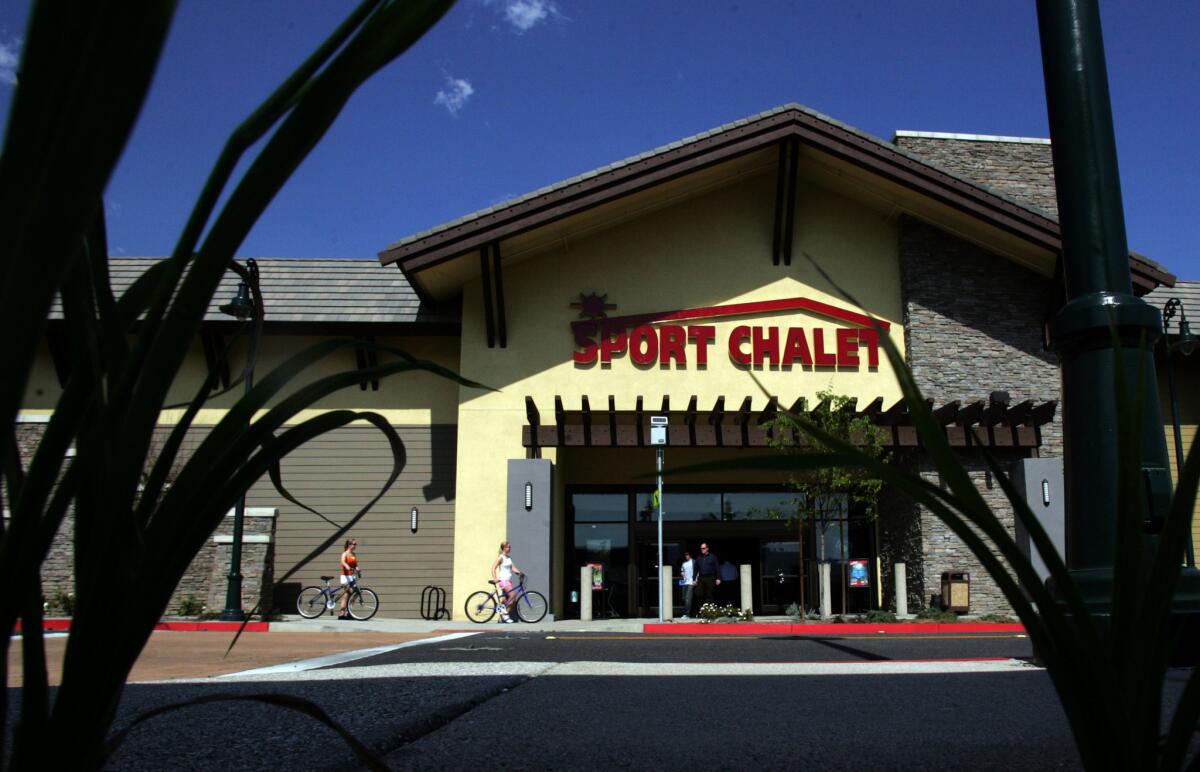Why sporting goods retailers are fumbling
- Share via
In sports, it’s an asset if you can play multiple positions.
If you’re a sporting goods retailer, trying to do it all often ends in defeat.
Sport Chalet learned that the hard way, abruptly announcing Saturday that it was closing all of its 47 stores. The La Cañada Flintridge-based chain spent years battling financial troubles and struggled to keep pace with changing consumer tastes that made for exceptionally fierce competition — even by retail standards.
A perennial money-loser for nearly the last decade, Sport Chalet was in business 57 years but couldn’t withstand pressures now coming from all sides: larger sporting goods rivals, big-box discounters, online retailers and specialty high-end brands all ate into the company’s market share.
As Americans become more health conscious and fitness focused, the sporting goods industry has grown steadily but also become increasingly specialized. If you want stylish $50 sports bras and $100 yoga pants, you go to Lululemon. Discount sporting equipment? Big 5. Top-notch customer service? REI. Cheap and casual workout clothes with a side of laundry detergent or toilet paper? Target or Wal-Mart will do.
Even mall staples such as Forever 21 and Gap have aggressively expanded their active wear offerings in recent years as they try to capitalize on the so-called athleisure market.
That left little room for Sport Chalet and similar chains. Its parent company, Vestis Retail Group, said Monday that it filed for Chapter 11 bankruptcy protection. Vestis also owns Eastern Mountain Sports and the apparel retailer Bob’s Stores.
“The big problem was that they weren’t focused on anything enough to carve a niche in the market,” said Rory Masterson, industry analyst at IBISWorld.
See more of our top stories on Facebook >>
Vestis’ brands aren’t the only sporting goods retailers to bow to those pressures. The much larger Sports Authority chain filed for bankruptcy protection last month, with plans to close 140 of its 463 stores nationwide and in Puerto Rico.
The U.S. sporting goods market totaled $63.7 billion in sales in 2014, the most recent year for which figures were available, according to the National Sporting Goods Assn. trade group. That was up 24% from 2009. Sporting goods retailers, excluding the mass merchandisers, employ nearly 315,000 people nationwide at 45,770 locations, according to the research firm IBISWorld.
About 1,200 jobs at Sport Chalet are now at risk with the chain’s closing.
Analysts said there were parallels between Sport Chalet and its beleaguered rival Sports Authority, including that both were saddled with debt after being acquired by other firms.
“If a retailer’s got a lot of debt, it means they’re not spending money on stores, they’re not spending money on systems, they’re not spending money on the kinds of things they need to do to drive the business forward,” said Matt Powell, an industry analyst at market research firm NPD Group.
Although Sport Chalet once marketed itself as being staffed by “the experts,” that customer help for specific activities has been matched by several of its rivals, Masterson said. And outdoor blogs and online reviews have also made in-store specialists less of a selling point.
Sport Chalet was known for catering to enthusiasts in winter sports, diving, marathon running and hiking, but ultimately it wasn’t enough.
In its fiscal year ended March 30, 2014, its last as a public company, Sport Chalet lost $10 million on sales of $344 million. Dick’s, with 645 stores, had sales of $7.3 billion in its fiscal year ended Jan. 30.
Dick’s and other industry leaders such as REI and Cabela’s Inc. also established stronger relationships with suppliers and developed the kind of leverage on the supply side that smaller operators like Sport Chalet were unable to match, Masterson said.
Those retailers were also ahead of the curve when it came to building an online presence, which put Sport Chalet at a disadvantage, he said.
Dick’s Chairman Edward Stack, who referred to the “unique time” in his industry during a conference last month, said Dick’s online sales jumped at a compounded annual rate of 39% from 2010 through 2015.
“These smaller operators are kind of unable to keep up just because they don’t have the resources to be able to keep up,” Masterson said.

Sport Chalet couldn’t withstand pressures coming from larger sporting goods rivals, big-box discounters, online retailers and specialty high-end brands. Above, a store in La Canada Flintridge.
The athleisure market for casual athletic clothing, which took off a few years ago, also has become increasingly crowded with big-box retailers such as Wal-Mart and Target, as well as fast-fashion brands joining the fray — often at cheaper prices.
“People are seeking out apparel and footwear as much for fashion as for actual activities,” said Joseph Feldman, an industry analyst at Telsey Advisory Group.
That trend also isn’t showing signs of slowing down, said Diana Smith, senior research analyst for retail and apparel at the research firm Mintel Group Ltd.
“All of that competition from a number of different retailers is putting pressure on the sporting goods stores,” she said.
“The consumer is smart enough to be able to shop around and know they can get some pretty quality athleisure [items] and they’re not confined to a sporting goods store,” Smith said.
That’s a challenge for every sporting goods chain, including El Segundo-based Big 5 Sporting Goods Corp., which has 438 stores. Big 5 remained profitable last year, earning $15.3 million on sales of $1 billion.
But in its annual report filed with regulators last month, Big 5 noted that “e-commerce has been a rapidly growing sales channel, particularly with younger consumers,” and that if the chain was unable to compete successfully in online sales “our operating results may suffer.”
Twitter: @PeltzLATimes, @smasunaga
MORE BUSINESS NEWS
With Tesla 3, German automakers are now seeing Tesla as a threat
Facebook advances new era in which information comes to you, no humans required
Trouble getting rental cars adds to problems for those waiting for Takata air bag repairs
More to Read
Inside the business of entertainment
The Wide Shot brings you news, analysis and insights on everything from streaming wars to production — and what it all means for the future.
You may occasionally receive promotional content from the Los Angeles Times.












